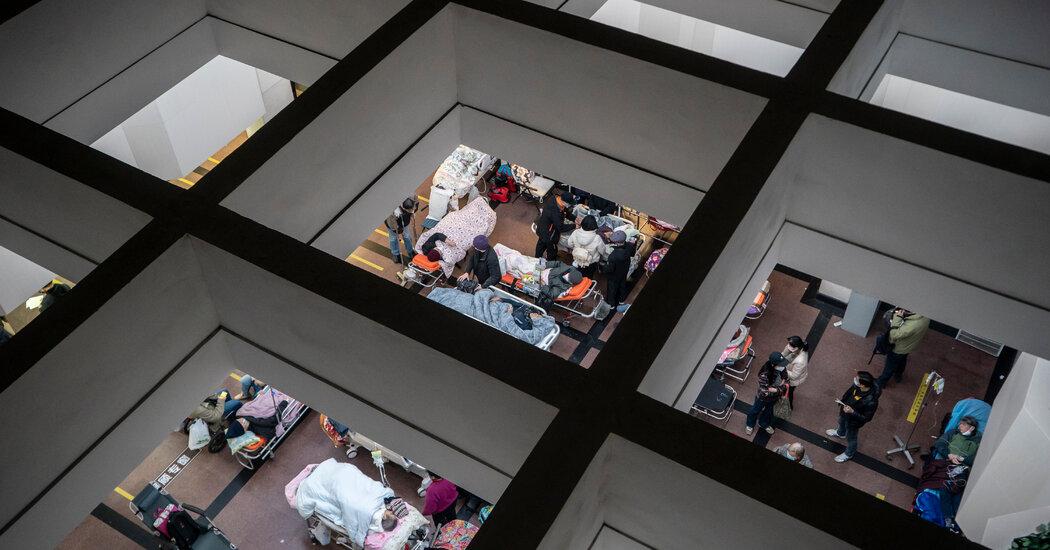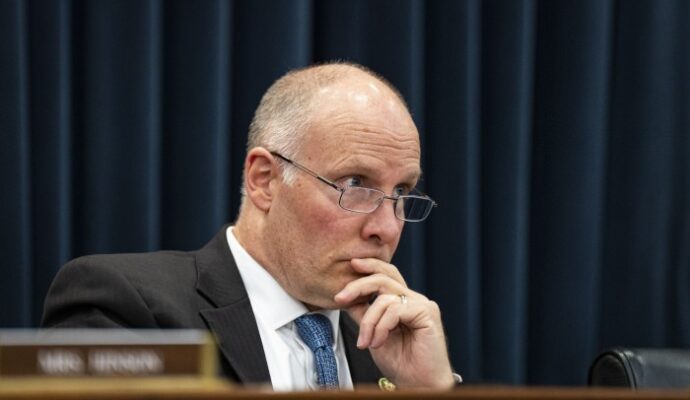
This transcript was created using speech recognition software. While it has been reviewed by human transcribers, it may contain errors. Please review the episode audio before quoting from this transcript and email transcripts@nytimes.com with any questions. [MUSIC PLAYING]
From “The New York Times,” I’m Sabrina Tavernise. And this is “The Daily.”
For nearly three years, China had one of the lowest COVID death rates in the world thanks to its strict but effective policy of zero-COVID. Last month, the Chinese government suddenly abandoned it. Today my colleague Alexandra Stevenson on the stunning about-face and what it tells us about China’s leadership.
It’s Tuesday, January 17.
So, Alex, the last time we talked about China on the show, it was after the mass protests in November. And they were the biggest in decades. And they were sparked by this fury people had at China’s COVID lockdown measures.
But then over the holidays, I was reading all of these headlines about this giant spike in COVID cases. So I want to ask you, what is happening right now in China? Tell me what’s going on.
Well, what we’ve seen is an incredible spike in COVID cases, millions of cases in cities all around the country. And we’ve seen images and videos on social media of people spilling out of hospital waiting rooms into hallways. And we’ve seen long lines outside of hospitals. And the picture is pretty dire.
- archived recording 1
[NON-ENGLISH SPEECH]
In one video, for example, you see this person wandering through a packed hallway. And he’s narrating. And you see people on gurneys. You see them in wheelchairs. They’re lined up against the walls. There’s really almost no room to walk through, there’s so many people.
- archived recording 1
[NON-ENGLISH SPEECH]
And he identifies the hospital. It’s one of the major general hospitals in the city of Tianjin.
- archived recording 1
[NON-ENGLISH SPEECH]
And the person says, “This is the emergency department. Some of these people have been in the hallways for days. Look at this, all of these people. What is going on here?”
- archived recording 1
[NON-ENGLISH SPEECH]
And he asks, “Are there truly no more wards available?”
Wow.
In another hospital in another city, you see just this scene of chaos where a lot of, I think, family members are crowding around this desk attendant. And maybe it’s a nurse. They’re in hazmat suits.
- archived recording 2
[NON-ENGLISH SPEECH]
And they’re facing this crowd. And one person shouts out, “There’s no oxygen. If you can’t even give him oxygen, how can you rescue him?”
Then it’s just these scenes of desperation. And we know that that’s happening all across the country.
So, Alex, this is a pretty dire picture that you’re painting. So how did COVID spiral so quickly in this country that for years had really managed to keep a lid on it?
So, Sabrina, zero-COVID was really effective for a long time at keeping the virus mostly out of China. But each time the virus mutated and became more transmissible, the government would have to come up with increasingly restrictive policies. People were having to take a PCR test every 24 to 48 hours sometimes just to be able to get on public transport, to get to work, to enter a shopping mall.
And it gets to the point where even the central government seems to realize that zero-COVID has run its course, that things may have gone too far, that it was just too restrictive on daily life. And in November, they actually start tweaking the restrictions to be a little looser but in small ways. And the government is still sticking to the main message, which is that zero-COVID is the winning strategy.
OK, so when do the protests enter the picture?
The government was already tweaking the policy before the protests actually began. But those little changes weren’t making really much of a difference in people’s daily lives. And so people are just getting more and more fed up. And then late in November, that’s when you see people’s frustrations with zero-COVID really spill out into public. And shortly after, in early December —
- archived recording 3
This morning, we’re following a major shift in China. The government is officially easing its strict zero-COVID policies that have constrained life there for nearly three years.
We do see a change in the messaging. And it’s dramatic.
- archived recording 4
Do we need to drop COVID zero, just that phrase now? I think we do.
On December 7, the government basically announces a series of huge changes.
- archived recording 4
Previously, catching COVID-19 here meant being sent to centralized quarantine facilities. Not anymore.
They put an end to makeshift isolation facilities. And there’s no more widespread lockdown in districts and entire cities. It gets rid of requirements for this mass testing, PCR mass testing that had really been the bedrock of its policy. And testing booths in cities like Beijing and Shanghai, where you had 10,000 or more testing booths, they just start disappearing. You see pickup trucks taking away these little portable stations.
Wow.
The government also gets rid of this health smartphone app that marked people as positive. And that was really the way that the government controlled movement and did its contact tracing. And all of this is just a massive change, especially because just days before, they had been saying zero-COVID is this winning strategy and we need to double down.
Yeah, it’s like complete whiplash, right? There’s no easing into this at all. It’s just bam, all things COVID are now just the opposite of what we said even a few days ago?
Yeah. And basically, the government said, from now on, if you’re sick, you’re on your own.
So at this point, what do we know about the COVID case numbers? How many cases are we talking about?
It’s a real mystery. And we’re really just trying to figure it out. We’re having this conversation the second week of January. And right now it’s not clear what the picture is. And that’s because for weeks, the official daily case count just hasn’t matched up with what we’re seeing, what we’re hearing. So, for example, this week, the government on one day gave a daily case count of just over 14,000 cases nationwide. And that doesn’t tally because what we’re seeing from local governments and districts and cities are numbers that are just wildly different.
What are those figures?
They’re in the millions a day.
Oh wow.
And one very striking figure that we got was from the province of Hunan, which is one of the most populous provinces in China. And they basically came out and said 89 percent of residents had already had COVID and it actually had peaked.
Huh.
Yeah, this is a province with almost 100 million people.
Wow.
Other provinces have given similar disclosures to Hunan, talking about a majority of residents having already gotten COVID. So I think it’s safe to assume that large parts of the country have already been inundated or are currently being inundated with COVID cases.
And what about deaths? Do you have any sense of how many people are actually dying from COVID in China right now?
We don’t know, actually, because the government figures just aren’t reliable. And they don’t seem to be quite right. So officially, as of January 9, the death count from the government was just under 40 COVID deaths across the country.
Very low.
Yeah. And then if you look even beyond that to the funeral homes, the crematoriums, we get another piece to the puzzle. You see video footage and photographs of long, long lines of hearses at funeral homes across the country. We’ve actually heard from crematoriums in public statements saying they can’t work fast enough. And we also hear from people saying they have to wait weeks just to be able to do a cremation ceremony for a family member. And when I talk to friends and contacts and acquaintances, it’s striking because everybody knows at least one person, if not many more, who have died, either family members or close friends or people within their inner circle.
Oh man. And, Alex, how do vaccines fit into this? What are China’s vaccination rates right now.
So, actually, 90 percent of the population of China has had two shots. So —
OK. That’s high.
Yeah, on the face of it, it’s quite high. But the WHO says you actually need three of the Chinese vaccines to be effective against severe disease because the Chinese vaccines use a more traditional technology. They don’t use mRNA. And so they’re just weaker.
So we know you need three shots. But the numbers start to drop off when we look at how many people have actually had a booster. And the numbers get particularly bad when you start to look at the most vulnerable sector of the population, which is people over the age of 80. Less than half of these people have had a booster at all.
And so as the government is pulling back from these restrictions, they do start this elderly vaccination campaign. But it feels halfhearted. And we don’t see evidence that really actually that many people are being vaccinated. And we haven’t had a recent picture from the government in terms of new numbers for how this new vaccination campaign is actually going.
OK, so it sounds like China didn’t really pour its efforts into vaccination rates, particularly when it came to the elderly. Instead, they had this single-minded focus on zero-COVID — the lockdowns in the apartment buildings, the app that was watching everything about your movements. But then, overnight, they went from that extreme to pretty much no restrictions at all. The government kind of just left the space entirely, which is weird, right, because this is precisely what governments are for, to do big, society-wide efforts for the good of the public. I mean, it’s just strange.
Yeah, it was striking, the change, because people were suddenly really left to fend for themselves. We heard from a lot of people describing the change as too abrupt. We also see public experts in other countries, they’re starting to scratch their heads.
Lots of people outside of China sort of assumed that when China would eventually decide to open up that it would take three to six months, some extended period of time to ease away from the restrictions. So as they lifted restrictions, they could have ensured that you had smaller case numbers and that you allowed the virus to play out. But sort of in a not so fast fashion, instead the government seems to have taken this rip-the-Band-Aid-off model.
Yeah, it’s like they learned nothing at all from what the rest of the world went through over the past three years. So I guess my question is, why? Why did the government do it this way?
You’re not the only one confused by this, Sabrina. That’s the question that everyone is asking themselves. No one expected things to play out this way.
We’ll be right back.
So, Alex, before the break, we were talking about why China’s ruling party did this sudden about-face from zero-COVID to essentially zero restrictions. So in your reporting, what did you find out about this question? What do you know about why China walked away from this policy so quickly?
Well, in China, so much of the government’s decision making is a black box. So we can only really look at what was happening in the weeks leading up to the sudden shift in early December. And the first thing that was happening was that you had Omicron, this highly transmissible variant that had breached China’s zero-COVID fortress. It was everywhere.
And there were indications that the testing apparatus that had been built to keep this virus out, it wasn’t working anymore. And, on top of that, it was becoming increasingly expensive and burdensome for local governments to continue. And so the virus is out there. So maybe the thinking was, maybe this is the moment that we let go.
Right. The idea is basically there’s already a hole in the dam. It’s inevitable that this thing is going to rip through. So we might as well let it go.
Exactly. And there’s definitely a narrative that started to emerge after the shift, where you had health experts, Chinese health experts saying, look, this is going to be really bad. And we’re going to get a lot of cases. But it’ll be over fast.
So that’s one thing that was happening in the weeks before. What else?
You also had an economic picture that was looking bleaker by the day. You have extremely high unemployment, especially among youth. And we know that a lot of people were suffering. They were being laid off from their jobs because companies were unable to continue operating, especially under situations where there were ongoing lockdowns or sudden lockdowns that would shut down entire factories for weeks at a time.
And, finally, there was political unrest. These protests that we’ve talked about, they were the closest events to happen before the rollback. It was very clear that people were fed up, just done, finished with this zero-COVID policy dictating all aspects, really, of their lives. And that political instability is the most immediate and threatening to the government.
And so the idea there is the government is worried that the political instability is going to get out of control, right, and they just decide to pull the ripcord and stop?
Right. It certainly seemed like a major factor. Again, we can’t say for certain and we may never know, but it’s hard to imagine that it didn’t play a big part.
And, Alex, what are China’s rulers saying to the Chinese people? I mean, they had been saying that China was the smartest country on Earth for having kept a lid on COVID. And they’ve just done a 180 completely, right? So how do they explain that? How are they managing this rhetorical pivot?
Well, first, they’re trying to create an impression that this transition was part of the plan all along. And then they start putting out messaging from top doctors, public health experts and officials saying this is not a big deal. Omicron is far less dangerous than previous variants. You’ll be sick for a couple of days, then you’ll be fine. You’ll have a high fever, but it’ll be all right. This is really not a big deal at all.
And, Alex, where is Xi in all of this? I mean, zero-COVID was in a way kind of his trademark, right? And now the virus is ripping through the country. What’s he saying?
Exactly. It’s fascinating because Xi Jinping doesn’t actually address the switch in zero-COVID for three weeks.
Wow.
It’s not until late December that he talks about this new approach, what he calls the new phase of the pandemic. He talks about how Chinese people have been so strong and that they’ve been through so much and are really, again, faced with another tough moment. And so he’s acknowledging the difficulties in the battle against COVID. But he’s really focusing on what he describes as the new dawn ahead, that this is all going to get better very soon.
So, Alex, what happens now in China? Where do things go from here?
Well, at this point, it’s hard to put the genie back in the bottle. According to epidemiologists, you can’t really go back once you’ve loosened restrictions. And there’s no use anyway because the virus is spreading so quickly. People have changed their behavior towards COVID. So what we will see is just more cases and presumably more deaths and more strain on China’s rickety health-care system.
And so we have Chinese New Year coming up. And a lot of the outbreaks have been in urban centers. But now as people travel home to see their families in more rural parts of the country, they’ll be bringing the virus to some of these places that are more remote. And that’s going to be the next big challenge for China. There’s one estimate that says that by April, 250 million people will have been infected.
Wow.
And as many as 1.7 million people will have died from COVID.
Alex, what does it mean about China that this is happening? I mean, we interpreted all of the COVID measures as Xi exerting more authoritarian control, right? And it fit into a pattern — the crackdown on Hong Kong, Xi taking more and more power for himself.
But suddenly, here we are, right, just kind of swinging in the wind. The controls are completely gone with great consequence to millions of people. So were we wrong about China’s government in what it was becoming? What are we to make of this?
That’s a big question. I think it’s still a little early to be asking these political questions. But certainly from the outside, you could see this as the government bending to the demands of the people. But if you look at the government messaging during zero-COVID, it was so much about how the Communist Party and China as a government places priority on people’s lives, whereas the rest of the world, they don’t care. But then the way that they did away with the policy overnight, it makes it feel more like those lives don’t matter anymore.
And I think more broadly, the one takeaway is that this policy that has suddenly been reversed, it all hinged on one person. And that’s Xi Jinping. He made zero-COVID his policy. And there’s this idea that when a person or a small group of people have so much power in a system where you have very little information about their decisions, it ends up creating a situation where you will get a very dramatic swing or a reversal. And nobody really can explain it. Something like a total reversal of zero-COVID can happen overnight and keep everyone guessing about what’s next.
And about why it happened.
And about why it happened.
Alex, thank you.
Thank you, Sabrina.
Over the weekend, China’s National Health Commission released new figures on the death toll from COVID. The government said that 60,000 people have died since the country’s COVID restrictions were lifted. The figure was released following pressure on China for more transparency in its COVID reporting. But many analysts believe the figure is still far lower than the actual death toll.
We’ll be right back.
[MUSIC PLAYING]
Here’s what else you should know today. Over the weekend, the White House announced that five more pages containing classified information were found at President Biden’s Delaware home, bringing the tally to six pages uncovered last week. Justice Department officials found the additional pages when they went to retrieve one page that had been identified in a storage area near Biden’s garage. Last week, the Justice Department appointed a special counsel to investigate whether Biden had mishandled the documents.
And a Russian missile slammed into an apartment building in the Ukrainian city of Dnipro on Saturday, killing at least 40 people. It was one of the war’s deadliest attacks in months. As of Monday, around 30 people were still missing and at least 75 were wounded.
The attack comes as Russia has claimed some modest success in terms of territory. The day before, Russia claimed to have taken the Eastern Ukrainian town of Soledar, its largest win on the battlefield in months. But the victory, analysts said, had come at a steep cost. Most of Soledar had been reduced to rubble and much of its population had fled.
Today’s episode was produced by Alex Stern, Diana Nguyen, and Stella Tan, with help from Shannon Lin and Clare Toeniskoetter. It was edited by MJ Davis Lin with help from Anita Badejo, contains original music by Marion Lozano and Dan Powell, and was engineered by Dan Powell. Special thanks to Zixu Wang. Our theme music is by Jim Brunberg and Ben Landsverk of Wonderly.
That’s it for “The Daily.” I’m Sabrina Tavernise. We’ll see you tomorrow.


